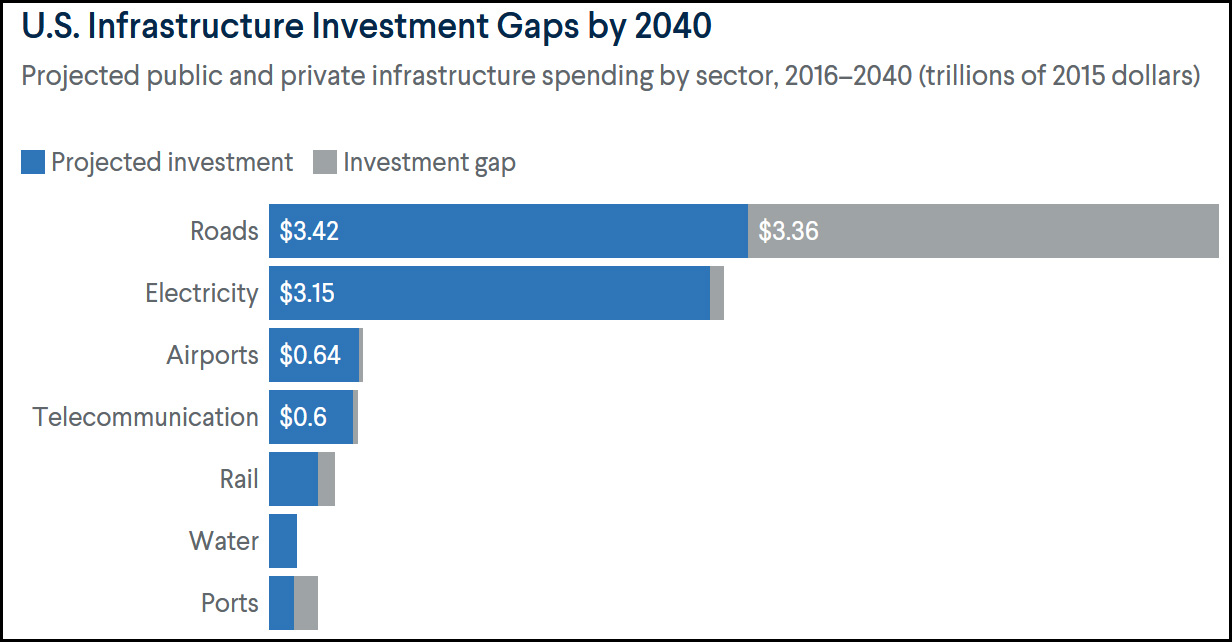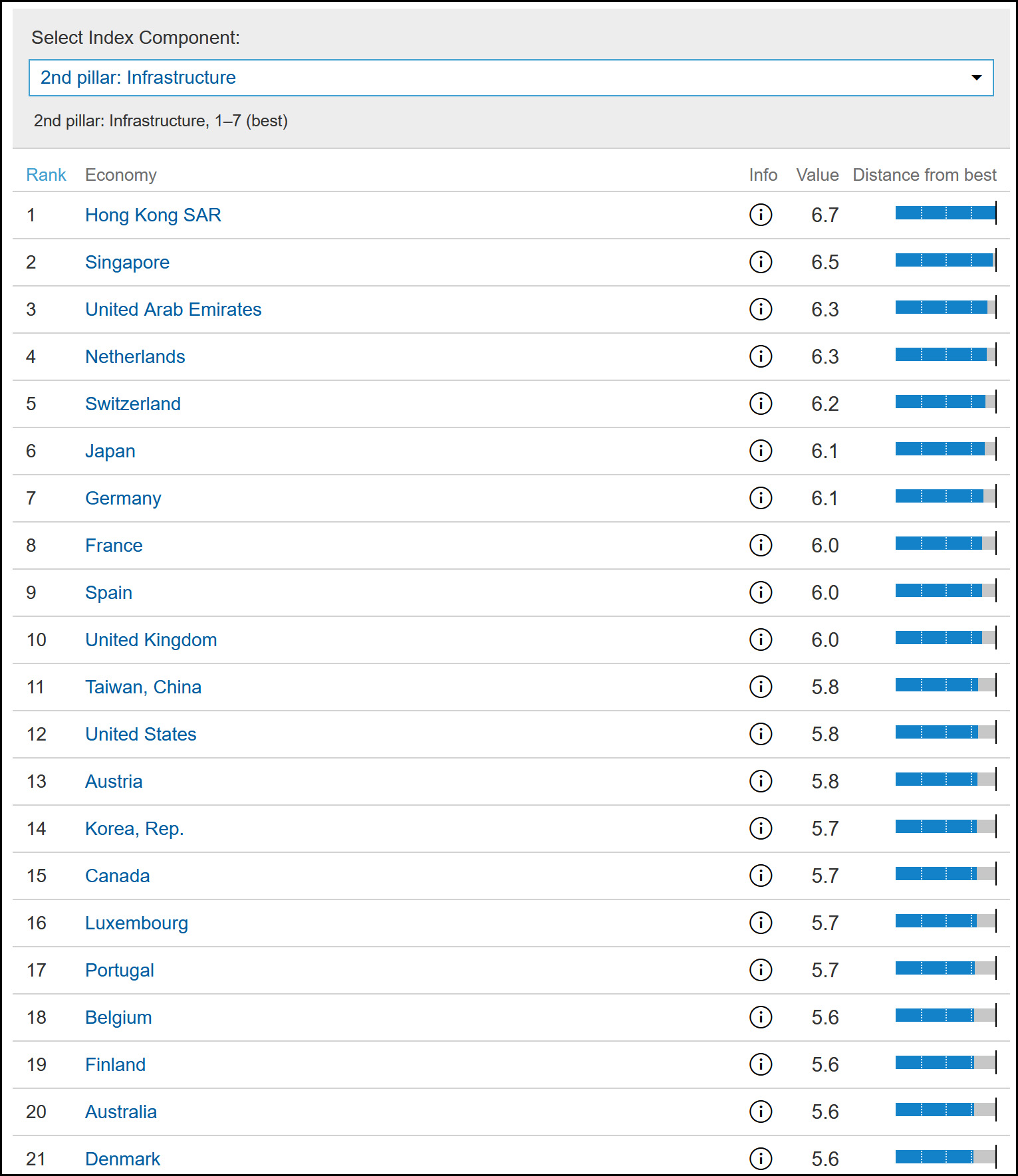Good news, folks! We've been working hard and our infrastructure is showing the results:

For years, the American Society of Civil Engineers has been awarding us a D+ for our infrastructure, but this year they've upgraded us to C-. Progress!
I continue to wish there was some reliable indicator of infrastructure quality other than ASCE, which obviously has a dog in this fight, but there's not much out there. However, here's a funding chart from the Council on Foreign Relations:

If this is to be believed, our "investment gap" between now and 2040 is basically pretty tiny—around $20 billion per year—for everything except roads. That's the only real gap. And by "roads," I suspect this mainly means "bridges."
The underlying data for this chart comes from the World Economic Forum's competitiveness rankings, which are split into several different areas. Overall, WEF ranks us third in the world in competitiveness, but only 12th in infrastructure:

This is for 2015, which is the most recent data they have. It's not great, but honestly, 12th in the world isn't all that bad. We're way ahead of Denmark!
This all leaves me a little confused, and I wish there were a more reliable marker of how good or bad our infrastructure really is. To be honest, my impression is that our infrastructure "crisis" has long been overblown. We can and should do better, but it's not as if the country is crumbling before our eyes.

Probably a lot depends on where you live and what you see around you. Here in PA the DoT puts out an annual list of bridges they have to close because they haven't been maintained, and potholes are a major cause of vehicle damage in most parts of the state. The whole southeastern corner of the state can't function without SEPTA, but it hasn't had reliable funding probably forever, even in high-traffic years. Gas tax revenue hasn't come close to funding road maintenance in well over a decade even though they're now about the highest in the region, so several years ago the (gop, natch) legislature started a program of looting PA Turnpike revenue, which the TP had to respond to by about tripling tolls. Several major bridges badly need work and the lawmakers' solution is to toll them. Etc, etc.
(To be fair, the TP Commission and legislature have both had killing the toll collectors' union as a major goal so setting up new toll points that use the automated EZPass system is at least a twofer for them.)
It isn't just transportation-- east of maybe the Dakotas and north of the Carolinas are a whole lot of 80- and 100-year-old clay sewer system parts and iron water pipes that often don't get touched until they break. Regulated utilities usually have to do mandated inspection and replacement programs so electric infrastructure isn't too bad, but if it's municipal, or spun off to an authority, it'll often be neglected or unusually expensive for users.
My bottom line is that states and regions are different wrt infrastructure and I'm guessing CA would actually come off pretty well compared to the Northeast and many parts of the South. But unfortunately I don't know of any sources for tracking that either.
The roads infrastructure figure must be to upgrade the roads so that they will work for "self-driving" cars. Otherwise there is no need to maintain the roads, since everybody now has an SUV with "off-road" capability. According to the commercials, driving off roads is better than driving on them.
But what if we wanted really efficient surface traveling, like bullet trains? Then the railroads would have to be improved a lot. The figure for rail obviously does not include even one bullet train (you know which one).
Infrastructure Week finally arrived... but the liberally biased media ignored it to avoid giving the Trump reelection any momentum.
Saying "This is Infrastructure Week" and not passing any bills, providing any money , or making any plans to, like, do anything, doesn't really count.
To be honest, my impression is that our infrastructure "crisis" has long been overblown
Likewise. I'd like us to do a lot more in terms of public transport, HSR, and smart energy grid*. But these things are more "liberal wish list" than a crisis, as such. And US airports in the main are just fine. They're not the glittering palaces I sometimes fly through in Asia, but that's mainly because they're older. Asian aiports won't look so fancy in 30 years, either. (Also, I don't fly that much in US these days, but, when I do, it seems that without fail the airport I happen to be using has some kind of major renovation going on; I reckon the money being spent at US airports of late is in the tens of billions annually).
*I'm no expert, but maybe California's forest-fire starting electricity grid really is in crisis mode, for obvious reasons.
Kevin, (if I may use the informal Kevin when addressing you?); Kevin, you are becoming a constant source of concern!
But maybe like the canary in the coal mine, it has its uses.
Now then, my secondary profession is trading lots of stocks....and I made good money on Trump's promise of an infrastructure bill...but sold it all also at good profit realizing Trump did not have the foresight or wisdom to understand that such an infrastructure/jobs project across America would easily guarantee him his re-election. (stupid, stupid man, did no one ever talk to him?)
Be that as it may, on the run up to and the election of Biden I bought into materials/engineering/basic commodities again, and done well, (believe me I have my losses also), but sold again in February, yet began buying back about two weeks ago...I'm not all in, but if you tell me that the Infrastructure bill is dead...I need to exit this position quickly stage left.
So what is it going to be? For me, voting rights first, whatever it takes, and secondly, Infrastructure. Legislatively, it looks like infrastructure first, Voting second...But now you are telling me, no Infrastructure bill at all!?!
Hummmmm
Best Wishes, a concerned Traveller along this wobble though life
Counterpoint -
CA wildfires and TX freeze show the inadequacy of our electrical grid.
The bridge situation is a disgrace.
Power and water systems are vulnerable to cyberattack.
Airline consolidation has reduced the number of active airports, and the ones left are an embarrassment compared to many other countries on this list.
But! We have a great high tech jobs program producing shiny junk for the world's #1 military!
Diverting a small fraction of the DoD budget to infrastructure projects could fix all these ills, while still keeping the masses gainfully employed, the country safe, and the gov't contactors fat & happy. It's all about priorities.
For WEF ranking, "infrastructure" is a very broad category that includes, for example, environmental regulation. It's correlation to road and bridge maintenance is weak. My experience, having bicycled on roads in many countries around the world, is that the quality of road system maintenance in the United States is well below #12 in the world.
Apropos of nothing, that infrastructure logo is pretty cool.
Also, let's keep in mind the "Build it Back Better" slogan. Roads geared for self-driving and driving assist vehicles. Buildings that are energy efficient and weatherized (no more water pipes in the external walls, for example). Maybe it's time for Oklahoma to have earthquate-resistant buildings.
Engineers will know the drill. Developers and builders will resist it. That's what regulation is for.
I frankly don't know what they are smoking at the Council of Foreign Relations. A tiny amount of investment needed for electrify? We are the only developed country that still supplies electricity with cables strung through the trees like abbey scouts project. Every summer the hurricanes tear them down and we string them back up, ready for the next hurricane. Power outages due to normal weather events are routine in this country. Ditto for winter storms. Not to even mention the upgrades required to deal with climate change.
Moving on: We do not have passenger rail for almost all of the country. Potholes all over the roads all over the US (if is not just the bridges, far from it). Streets sliding into the ocean (not all that far from Orange County).
Truly: What ARE they smoking?
Infrastructure standards. Where do you want to set the bar? "Not crumbling before our eyes" seems very low. Except for highways, it seem like this country is stuck on maintaining standards that were set in the late 19th century. Maybe it's time to update those standards to aim toward the future, rather than the past? And how come recreational infrastructure (parks, natural resources) aren't included in the list?
long time reader (political animal days) first time commenter:
First, glad youre doing well Kevin.
My very young adult children have always complained about the schools they attended and the roads we drive on. Having been abroad, they think the US is a laughing stock. Im an Interior Designer and got the new I.D. mag yesterday. Casually looking thru it, my 19 yr old son saw a very cool looking elementary school featured, then saw that it was in Vietnam and exclaimed "WTF?!, I had class in a f***ing Trailer!"
Our infrastructure failings are glaringly obvious to anyone paying attention Time for the new CCC.
In areas of the country losing population and employment, I can guess that infrastructure is also suffering, simply from loss of tax base.
The "telecommunications" category, does that cover broadband for everyone?
> around $20 billion per year
How did you compute that? The chart says the gap is somewhat over $3 trillion 2015-dollars over something like 25 years, which my calculator says works out to $120 billion 2015-dollars per year.
Oh, I see now.
Hi
Here (NZ) we have a useful "measure" of our infrastructure - local councils look after their infrastructure and the best measure is the AGE of the infrastructure
Everything has a lifespan - so you need to be continually working to stay in the same place - you need to do enough repairs and replacement to keep the "age" of your infrastructure assets the same
If you start with an average age of 25 years then after a year the age will be 26 years old UNLESS you have done sufficient replacement to keep the average at 25 years
If you cut down on maintenance and replacement than you are giving the next council a bigger problem
When we introduced this it caused council tax bills to go up - but we are now in a steady state condition where we are running fast enough to stay in the same place
Comparing our crappy infrastructure status to crappier status of other nations does not impress me much.
In the 2nd chart, worth noting the first three countries are really city-states, in the case of the UAE several city-states. Who also invest a lot in infrastructure because they literally need to create land to grow. Lived in Hong Kong and saw that first hand.